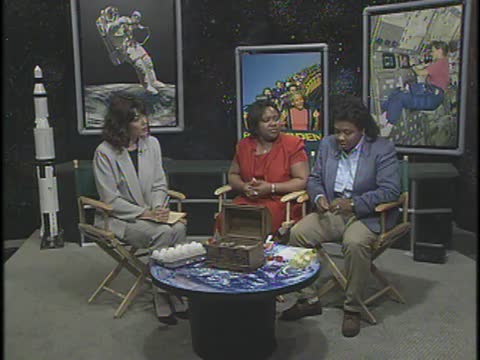Connect; Doing More in Less: Microgravity
- Series
- Connect
- Episode
- Doing More in Less: Microgravity
- Producing Organization
- Busch Gardens (Williamsburg, Va.)
- Langley Research Center
- Computer Sciences Corporation
- WHRO (Television station : Norfolk, Va.)
- Contributing Organization
- The Walter J. Brown Media Archives & Peabody Awards Collection at the University of Georgia (Athens, Georgia)
- AAPB ID
- cpb-aacip-526-jd4pk0855b
If you have more information about this item than what is given here, or if you have concerns about this record, we want to know! Contact us, indicating the AAPB ID (cpb-aacip-526-jd4pk0855b).
- Description
- Series Description
- "There is a general agreement among government leaders, educators, and concerned citizens that science and technology continue to exert greater influence on every aspect of our daily lives. Indeed, studies including Project 2061, 'Science for All America,' and 'Third International Mathematics and Science Study' (TIMSS) testify to this position. These same studies remind us that today's youth, especially those belonging to underrepresented groups, will be seeking jobs in a marketplace that requires levels of technical competence and critical thinking and reasoning skills needed by only a few workers in the past. To participate fully and effectively in a global economy and to make informed and reasoned decisions about the world's most pressing issues, students need to become scientifically literate and to acquire and apply fundamental competency in math and science. Unfortunately, these same studies tell us that today's youth are neither scientific literate nor do they have the requisite math and science competencies. "NASA CONNECT, which emphasizes the national mathematics and science standards, offers educators a tool to increase scientific literacy and to improve the math and science competencies of upper elementary and middle school students. Now in its third year of production, this award winning program is free to educators; there are no fees or licensing agreements required. Nationally, over 12,000 teachers and 800,000 students participate in the 1998-1999 NASA CONNECT series of five programs. Each program in the series consists of a 30-minute instructional program that is delivered via television and Internet. A web based component, designed to complement and extend the program, facilitates the connection between the classroom and the home. These electronic visits to the workplace, the inclusion of real engineers and scientists in each program, and the use of aeronautical themes (1) expose students to innovative research; (2) raise student awareness of careers requiring math and science knowledge; (3) show students the application of math and science on the job; (4) present math and science as a process requiring creativity, critical thinking, and problem-solving; (5) demonstrate workplace math and science as a collaborative process; and (6) help to overcome stereotyped beliefs by presenting women and minorities performing challenging engineering and science tasks. The instructional technology components (i.e., Web Panel of Experts, On-line Project, and Web Chats) (1) permit students real or near real interaction with engineers, scientist, and technicians; (2) expose students to careers in science and technology; (3) allow home bound and children schooled at home access to the resources and programs experienced by students in a traditional classroom setting; and (4) are easily integrated into local and regional instructional technology initiatives. Formative and summative evaluation, involving both educators and students, is used to assess NASA CONNECT. Feedback from educators indicates that NASA CONNECT is a valuable instructional opportunity and that the lesson materials and classroom activities are developmentally appropriate and that the programs in the series enhance the teaching of math and science and are easily integrated into the curriculum. Students, especially those in underrepresented groups, report that after watching NASA CONNECT they are more interested in learning math and science, state that math and science are not 'boring,' and that they are better able to understand the math and science concepts covered in class."--1998 Peabody Awards entry form.
- Broadcast Date
- 1998-04-24
- Asset type
- Episode
- Media type
- Moving Image
- Duration
- 00:30:31.444
- Credits
-
-
Producing Organization: Busch Gardens (Williamsburg, Va.)
Producing Organization: Langley Research Center
Producing Organization: Computer Sciences Corporation
Producing Organization: WHRO (Television station : Norfolk, Va.)
- AAPB Contributor Holdings
-
The Walter J. Brown Media Archives & Peabody Awards Collection at the
University of Georgia
Identifier: cpb-aacip-cbe8a76c1a6 (Filename)
Format: Betacam: SP
Duration: 0:28:34
If you have a copy of this asset and would like us to add it to our catalog, please contact us.
- Citations
- Chicago: “Connect; Doing More in Less: Microgravity,” 1998-04-24, The Walter J. Brown Media Archives & Peabody Awards Collection at the University of Georgia, American Archive of Public Broadcasting (GBH and the Library of Congress), Boston, MA and Washington, DC, accessed December 22, 2025, http://americanarchive.org/catalog/cpb-aacip-526-jd4pk0855b.
- MLA: “Connect; Doing More in Less: Microgravity.” 1998-04-24. The Walter J. Brown Media Archives & Peabody Awards Collection at the University of Georgia, American Archive of Public Broadcasting (GBH and the Library of Congress), Boston, MA and Washington, DC. Web. December 22, 2025. <http://americanarchive.org/catalog/cpb-aacip-526-jd4pk0855b>.
- APA: Connect; Doing More in Less: Microgravity. Boston, MA: The Walter J. Brown Media Archives & Peabody Awards Collection at the University of Georgia, American Archive of Public Broadcasting (GBH and the Library of Congress), Boston, MA and Washington, DC. Retrieved from http://americanarchive.org/catalog/cpb-aacip-526-jd4pk0855b
